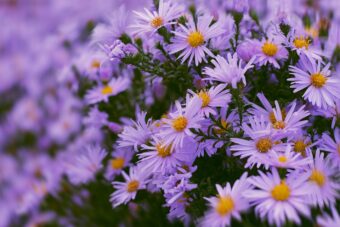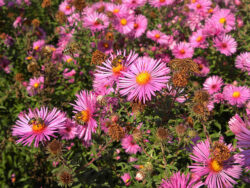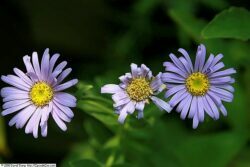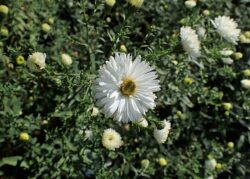In this article, we will discuss how to grow perennial asters in containers. Often in autumn our gardens are starting to look less colourful and in greater disarray with fewer plants in bloom.

To fill this gap Asters are useful. Asters just recently have become a mind field as so many have been scientifically renamed. The New England asters have been given a new name of Symphyotrichum novi-anglae and the Michaelmas daisy is now a Symphyotrichum novi-belgii. As they have these new names they still remain with the tag of Aster and you will probably find it sold as Aster.
They are grown not only because they flower in autumn but because of the colourful flowers they come in. The bushy plants are covered in single or double blooms in a range of jewel colours- rich carmines pinks, dark purples and blues. They also come in shades of whites, where almost all blooms have yellow centres.
A great addition to any autumn container display. It also provides nectar and pollen to insects at a lean time of the year.
These hardy perennials can be in flower from late summer to mid-autumn.
HOW TO PLANT ASTERS IN CONTAINERS
Asters like to be grown in compost that is moisture-retentive but free-draining and is organic matter rich. They prefer to be grown in light shade but they can take full sun. It is best to buy them as young plants and plant them in groups in two or three containers.
Fill a 40cm diameter container that has drainage holes with a 2.5cm layer of grit. This will allow excess water to drain away and prevent the plant from getting root rot.

Fill the pot with a good quality of moisture-retentive, multipurpose compost. Dig a hole that is slightly bigger than the root ball the plant comes out of the original container. Place the plant in at the same level it came in the original container- no shallower or deeper. Backfill with the growing media and use more compost to fill any gaps that remain. Firm the plant in and water well.
Ensure that there is an adequate gap between the plants as this will aid with air circulation and prevent one disease that Asters tend to suffer from- powdery mildew.
Water well until the plant is established and when periods of dry weather has been forecasted.
Once flowering has finished, you can either let them be or cut them back to the ground. As they are hardy you will not need to overwinter them.
Asters are not heavy feeders but an annual feed of slow-release fertilizer in spring will give enough nutrients to last it through the growing season. After a few years, it will need dividing to maintain vigour. Divide in spring as new growth begins.
PESTS AND DISEASES
As indicated in this article, they do suffer from powdery mildew that shows up as white fungal coating on the leaves. To prevent plants from suffering from this disease, plan to have gaps between the plants to promote air circulation. You can spray with a fungicide to see if it helps.

They can also suffer from rust where brown leaf spots can be predominate on the leaves. To make sure the plant is not under stress by overwatering or underwatering, and removing all fallen spent material.
They can also suffer from botrytis, especially if the plant is under stress- a grey mould will be noticed on the leaves and flowers. The leaves will also start to shrivel up. Improving air circulation and making sure the plant is not in too much humidity will help prevent this.
They are not really attacked by pests but slugs and snails can be a problem when the plant is young.
VARIETIES TO GROW
Many varieties can be grown but the following are suitable to grow in containers.
Aster x frikartii ‘Monch’ has good mildew resistance and has blue flowers with yellow centres.

Aster amellus ‘Veilchenkonigin’ has excellent deep purple flowers with yellow centres. It has a very long flowering season.
Symphyotrichum novi-belgii ‘Vasterival’ has tall, light, airy purple-pink blooms on top of dark ebony stems.
Symphyotrichum novae-angliae ‘September Ruby’ has ruby red, daisy-like flowers with yellow centres.
Aster novi-belgi ‘Lady in Blue’ has vivid, lavender-blue flowers with yellow centres.
Aster novi-belgii ‘Professor Anton Kippenberg’ has deep lavender flowers with darker centres.
Aster novi-belgii ‘Snow Cushion’ produces masses of white flowers with yellow centres.
CONCLUSIONS
In this article, we have discussed how to grow Asters in containers. Although a lot of them have been moved to a new genus, they will be asters to a lot of gardeners. They are easy to grow, look after and have many delightful colourful blooms. They do not need much, watering when there is a heatwave and the plant is dry, an annual feed, and cutting back after they have finished flowering.
If you have any questions or comments that you to make on growing Asters in containers, please do so in the comment box below.
